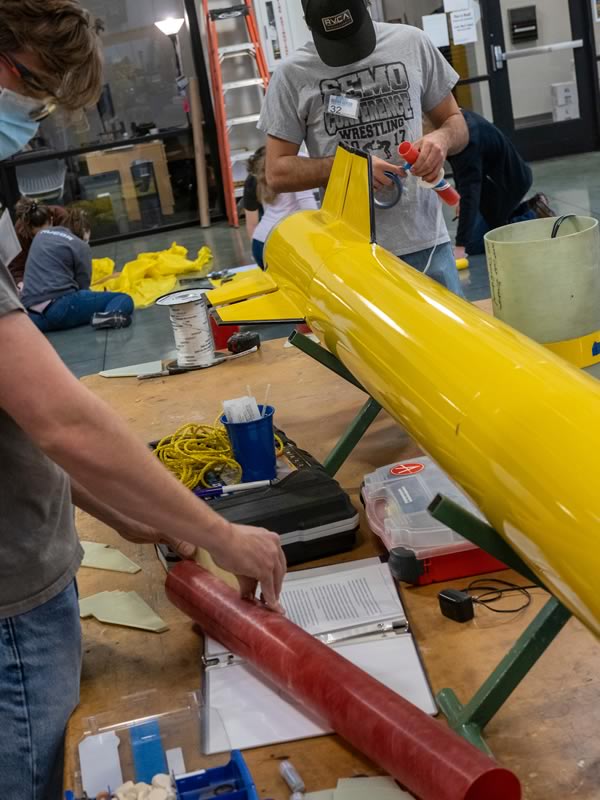General Information
The non-thesis Master of Science program in aerospace engineering at Missouri S&T offers multiple opportunities for advanced graduate studies. Non-thesis master’s students will greatly update and enhance their technical skills in areas of advanced manufacturing, aerospace, energy, materials and structures, micro/nano systems through the state-of-the-art curriculum. The program is offered on campus and via distance education, so that students can access the lectures anywhere at any time. A wide range of courses in aerospace engineering is available with multiple focus areas of study, including composite materials and structures, control systems, energy conversion and transport, engineering mechanics, and manufacturing automation, etc.
Please note that the students can choose the courses from the focus areas of study they are interested in, and the degree itself is purposefully flexible so the students can tailor the coursework to their needs. Typically, there are two to four courses within each focus area that are offered each year that our advisors highly recommend for students who are interested in one or more of these pathways. The remainder of the courses are to complete the degree. Other courses that round out the degree program will be chosen in consultation with and approved by the student’s advisor.
Admission Requirements
- BS degree in the same discipline
- GPA: Minimum undergraduate GPA 3.0
- GRE: Verbal + Quantitative 302, Analytical Writing 3.5
- Transcripts: Official transcripts required
- English proficiency test score requirements: TOEFL 80, IELTS 6.5, PTE 58, Duolingo 115
- Other requirements: Resume/CV, Statement of Purpose
Program Requirements
- Complete at least 30 total credit hours of lecture courses
- Complete at least 24 credit hours in the MAE department
- Complete at least 9 credit hours of 6xxx lecture courses, at least 6 credit hours of which are in the MAE department
- 6 credit hours of lecture courses can be taken out of the MAE department
List of Courses (24 credit hours must come from the list below; 6 credit hours of lecture courses out of the MAE department can be taken with the advisor’s approval)
- MECH ENG/AERO ENG 5001: Intro to Design Optimization (3 credit hours, offered every Fall)
- AERO ENG/MECH ENG 5001: Machine Learning for Manufacturing Automation (3 credit hours, offered every Spring)
- AERO ENG/MECH ENG 5001: Smart and Multifunctional Materials (3 credit hours, offered every Spring)
- MECH ENG/AERO ENG 5131: Intermediate ThermoFluid Mechanics (3 credit hours, offered every Fall)
- AERO ENG 5169: Intro to Hypersonic Flow (3 credit hours, offered every Fall)
- AERO ENG 5171: V/STOL Aerodynamics (3 credit hours, offered every other Fall)
- MECH ENG/AERO ENG 5212: Intro to Finite Element Analysis (3 credit hours, offered every Fall)
- MECH ENG/AERO ENG 5234: Stability of Engineering Structures (3 credit hours, offered every other Spring)
- MECH ENG/AERO ENG 5236: Fracture Mechanics (3 credit hours, offered every Fall)
- AERO ENG/MECH ENG 5282: Intro to Composite Materials & Structures (3 credit hours, offered every Spring)
- MECH ENG/AERO ENG 5307: Vibrations I (3 credit hours, offered every Fall)
- MECH ENG/AERO ENG 5313: Intermediate Dynamics (3 credit hours, offered every Fall)
- AERO ENG 5353: Aeroelasticity (3 credit hours, offered every other Fall)
- AERO ENG 5361: Flight Dynamics - Stability and Control (3 credit hours, offered every Spring)
- AERO ENG/MECH ENG 5449: Robotic Manipulators and Mechanisms (Lab 1 credit hour, lecture 2 credit hours, offered every Spring)
- AERO ENG/MECH ENG 5478: Mechatronics (Lab 1 credit hour, lecture 2 credit hours, offered every Spring)
- MECH ENG/AERO ENG 5481: Mech & Aero Control Systems (3 credit hours, offered every Fall)
- MECH ENG/AERO ENG 5519: Advanced Thermodynamics (3 credit hours, offered every Fall)
- MECH ENG/AERO ENG 5527: Combustion Processes (3 credit hours, offered every Fall)
- AERO ENG 5535: Aerospace Propulsion Systems (3 credit hours, offered every Spring)
- MECH ENG/AERO ENG 5570: Plasma Physics I (3 credit hours, offered every Fall)
- AERO ENG 5614: Spaceflight Mechanics (3 credit hours, offered every Spring)
- MECH ENG/AERO ENG 5715: Concurrent Engineering (3 credit hours, offered every Fall)
- AERO ENG/MECH ENG 5760: Probabilistic Engineering Design (3 credit hours, offered every Spring)
- AERO ENG/MECH ENG 5830: Applied Computational Methods (3 credit hours, offered every Spring)
- AERO ENG 6001: Methods in Orbit Determination (3 credit hours, offered every other Fall)
- AERO ENG/MECH ENG 6131: Gas Dynamics I (3 credit hours, offered every other Spring)
- MECH ENG/AERO ENG 6135: Turbulent Flows (3 credit hours, offered every other Fall)
- AERO ENG/MECH ENG 6212: Advanced Finite Element Analysis (3 credit hours, offered every Spring)
- MECH ENG/AERO ENG 6284: Analysis of Laminated Comp. Structures (3 credit hours, offered every Fall)
- AERO ENG/MECH ENG 6307: Advanced Vibrations (3 credit hours, offered every Spring)
- AERO ENG 6614: Advanced Astrodynamics (3 credit hours, offered every other Spring)
- AERO ENG/MECH ENG 6657: Laser Aided Manufacturing & Mat. Process. (3 credit hours, offered every Spring)
Visit course availability to see the full list and timing.
Please note: During the semester, a student will have completed nine hours of graduate credit, the student must formally plan the remainder of their graduate program in consultation with their academic advisor, and submit a Form 1 for approval, first to the department chair and then to the vice provost of graduate education.





Follow Mechanical and Aerospace Engineering